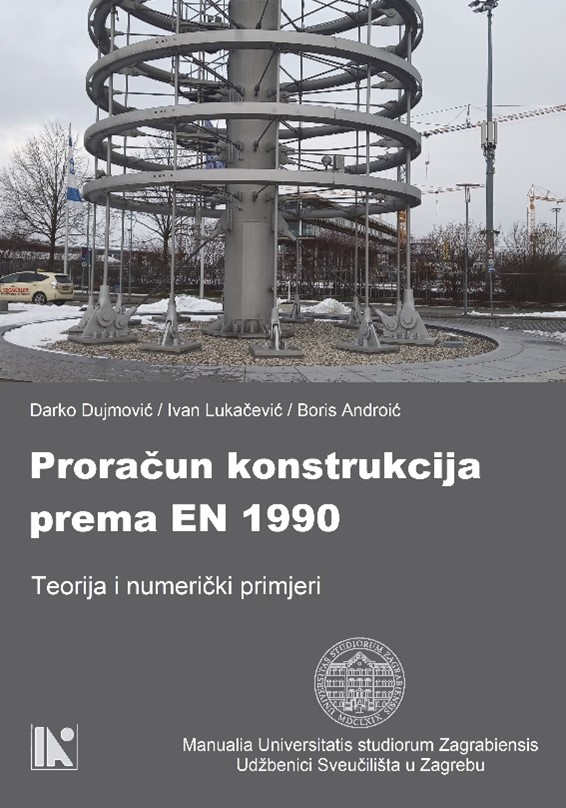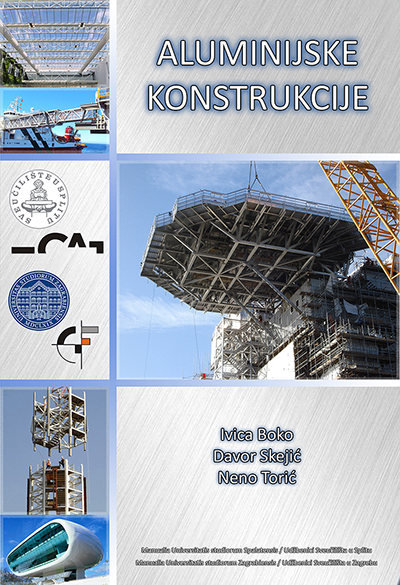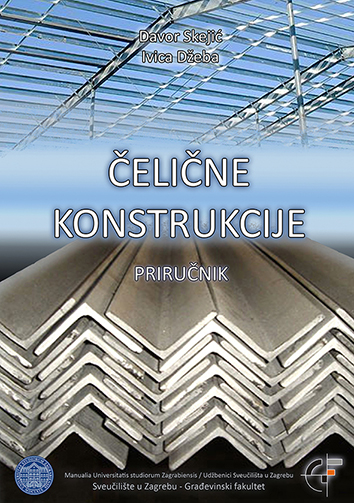| Hrvatski |
University textbooks of the Chair for Metal Structures
| Dujmović, Darko; Lukačević, Ivan; Androić, Boris: DESIGN OF STRUCTURES ACCORDING TO EN 1990: THEORY AND NUMERICAL EXAMPLES, IA Projektiranje, Textbook of the University of Zagreb, Zagreb, 2020. | |
University Textbook DESIGN OF STRUCTURES ACCORDING TO EN 1990: THEORY AND NUMERICAL EXAMPLES by Prof. Darko Dujmović, PhD., a retired professor from the Faculty of Civil Engineering, University of Zagreb and a full member of the Croatian Academy of Engineering, Asst. Prof. Ivan Lukačević, PhD., from the Faculty of Civil Engineering, University of Zagreb, and Prof. Boris Androić, PhD., a retired professor at the Faculty of Civil Engineering, University of Zagreb and emeritus of the Croatian Academy of Engineering, presents indispensable literature for students, as well as engineers in practice in the field of structural reliability engineering. |
 |
| REVIEWERS Prof. Neven Kuspilić, PhD. Assoc. Prof. Mladen Bulić, PhD. Prof. Emerit. Bernardin Peroš, PhD. |
|
| SUMMARY OF THE BOOK The textbook 'Design of structures according to EN 1990: Theory and numerical examples', along with defining and explaining the basic concepts from the theory of reliability, deals with the practical application of the EN 1990 standard through numerous numerical examples. The textbook also highlights some of the guidelines for the future development of this standard. The basic and guiding standard EN 1990 correctly recognises that achieving more demanding goals of structural behaviour cannot be guaranteed by deterministic expressions but can only be formulated by probabilistic expression and that these goals have limitations in terms of economy. The new generation of EN 1990 will elaborate on existing concepts with the introduction of some new ones, and this book provides clarification of terms (partial factor method, structural reliability method, calibration, failure probability, etc.) that need to be known. The revision of the existing EN 1990 standard is carried out for various reasons, including technological development, the need to extend the standard to specific areas (long-span bridges, high-rise buildings, slender structures, etc.), experience in applying existing standards, the need to harmonise the standard, the introduction of new insights of scientific research as well as socio-economic changes and changes in standardised climate action. The textbook consists of the following chapters: Basic variables and models, Element reliability, System reliability, Reliability in EN 1990, Practical application of EN 1990, Extension of EN 1990, and Concluding remarks. |
|
| Boko, Ivica; Skejić, Davor; Torić, Neno: ALUMINIUM STRUCTURES, University of Split, Faculty of Civil Engineering, Architecture and Geodesy, Textbook of the University of Split and Textbook of the University of Zagreb, Split, 2017. | |
The lack of literature in Croatian language in the field of aluminium structure design encouraged the creation of the book Aluminium Structures, which was approved as a University Textbook at both universities of the authors. The authors, from the Faculty of Civil Engineering, Architecture and Geodesy, University of Split and the Faculty of Civil Engineering, University of Zagreb, Prof. Ivica Boko, PhD., Assoc. Prof. Davor Skejić, PhD., and Asst. Prof. Neno Torić, PhD., hope that this textbook will contribute to the systematic education of students and be an incentive for greater use of aluminium alloys in civil engineering. |
 |
| REVIEWERS Prof. Ivica Džeba, PhD. Prof. Damir Markulak, PhD. Prof. Vlatka Rajčić, PhD. Prof. Alen Harapin, PhD. Assoc. Prof. Mladen Bulić, PhD. |
|
| SUMMARY OF THE BOOK Insufficient education with the tendency of architects and builders to traditionally rely solely on the advantages of classical building materials is the cause of the extremely rare use of aluminium, i.e. aluminium alloys in structures. The main goal of this textbook is to sensitise the professional public to a greater application of this light metal, which is an alternative to traditional steel, and even in some situations the only logical choice. The university textbook Aluminium Structures by Ivica Boko, Davor Skejić, and Neno Torić certainly very successfully fills the gap in Croatian professional publishing that existed in this specific field of construction, which includes structures made of aluminium alloys. This textbook is included in the university literature at both universities of the authors - the University of Split and the University of Zagreb. In this extensive work, the specifics of aluminium as a material are analysed in detail and methodically very clearly in 12 chapters, its favourable and unfavourable properties, as well as all significant aspects of the design of structural parts and structures made of aluminium alloys. Although similar in many ways, steel and aluminium alloys as building materials still have their specifics, knowledge of which is a necessary precondition for the successful design and construction of metal structures, and the necessary attention is given to that fact in this work as well. This applies in particular to the procedures for selecting the base material, the types of cross-sections and the joining methods. The use of modern literature sources and the application of a well-tried methodological concept of more detailed interpretation of relevant standards in the field should be pointed out, which is very useful, not only for students of civil engineering and architecture but also for the engineers in practice. Due attention was paid to the area of fire protection of aluminium structures because of the increased sensitivity of this type of structures to fire loads. As is common in the professional literature, the work also contains several illustrative numerical examples that help to better understand and adopt the given material. The textbook Aluminium Structures is intended primarily for undergraduate, graduate and postgraduate students of civil engineering and will be very useful for students of architecture. In addition, the textbook is a contribution to the development of the process of lifelong education of civil engineers in practice. Namely, this textbook is the first comprehensive literature in the Croatian language that deals with the design of aluminium structures in accordance with European standards - Eurocode 9. |
|
| Skejić, Davor; Džeba, Ivica: STEEL STRUCTURES, University of Zagreb, Faculty of Civil Engineering, University Handbook, Zagreb, 2015. | |
University Handbook Steel Structures by Assoc. Prof. Davor Skejić PhD. and Prof. Ivica Džeba PhD. from the Faculty of Civil Engineering, University of Zagreb, was created for the practical part of teaching the course Metal Structures, which is held in the third year of undergraduate studies and represents the first concrete encounter with metal structures. The handbook is based on the author's many years of experience in educating students, but also in the supervision and the design of steel structures. For this reason, this handbook represents the basis of civil engineering work in the field of steel structures. |
 |
| REVIEWERS Prof. Ivica Boko, PhD. Prof. Damir Markulak, PhD. |
|
| SUMMARY OF THE BOOK The handbook ‘Steel Structures’ by Davor Skejić and Ivica Džeba fully confirm the fulfilment of the basic intention of the authors stated in the preface. Namely, it is really successful and optimally prepared work, both in terms of scope and relevance of the given information, for the first practical encounter of undergraduate students of civil engineering faculties with metal structures. Detailed explanations of appropriate professional terms that follow their applicability in practice and frequent citation of relevant standards, i.e., literature sources, greatly facilitate the use of this manual. The authors elaborated the content in five chapters, four of which provide necessary prior knowledge needed to follow and understand the design method of simple ground floor steel building - hall. Thus, the first chapter gives an overview of the basic construction products for steel structures, and the text itself is supplemented with appropriate figures that greatly help in the practical presentation of the appearance of certain types of steel products. For each individual type of elements the method of production, relevant properties as well as possibilities of application in real structures are listed. The second chapter briefly provides an overview of the basic properties of structural steel to the extent necessary to follow effortlessly the way of solving a numerical example. The third chapter deals with a very important issue in the design practice concerning metal structures, and that is ensuring the global stabilization of the structure. This chapter is very important for the fundamental understanding of the principles of the design of metal structures, and accordingly, it is given the appropriate importance in the manual. Starting from the simplest forms to the more complex ones, the authors very vividly explain the necessity but also practical examples of the correct solution to the issue of global stabilization of the structure. The fourth chapter provides an overview of the basic loads on buildings as well as ways to combine them in order to determine the relevant effects on individual structural elements and the building as a whole. Climatic actions (snow and wind) are represented for the territory of the Republic of Croatia, and even at the first encounter with the methods of determining these loads students can get an impression of the importance of certain load type for the respective areas of our country. Finally, the fifth chapter provides a practical example of designing and calculating a simpler ground floor building (hall) while respecting the relevant norms and rules of the profession. Wherever possible, the authors provide several possible solutions of solving a particular problem and discuss the advantages and consequences of applying each one of them. |
|


 Pristupačnost
Pristupačnost